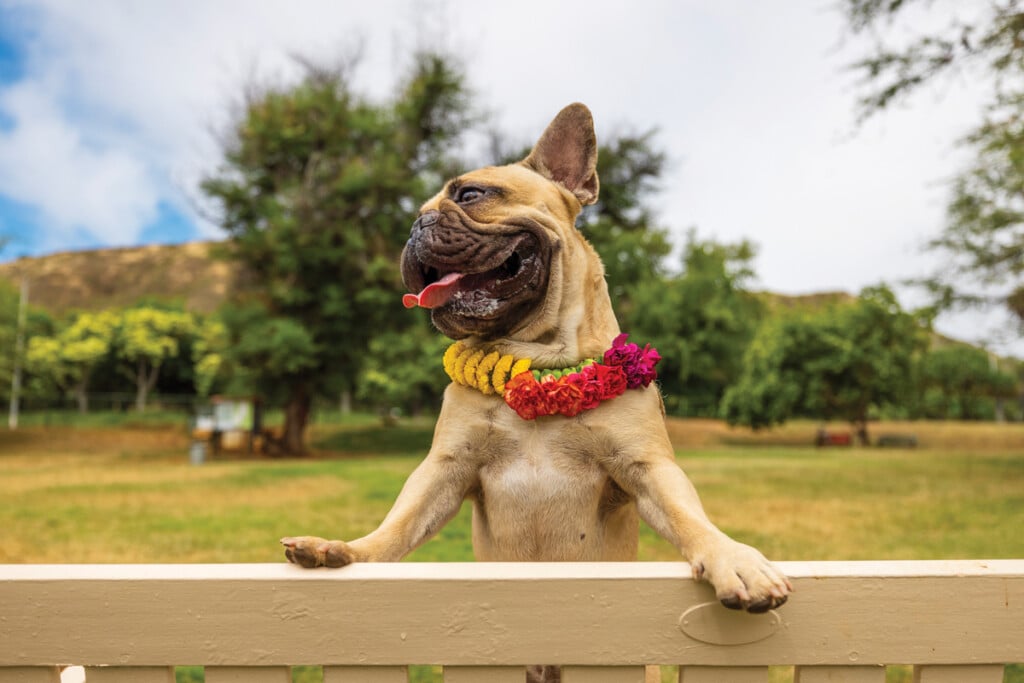Ensuring the Safety of Our Pets: The Necessity of Disaster Preparedness
Pet owners, don’t delay—here’s how to keep your pets safe and prepare them for the upheaval of disasters like hurricanes or fires.

Photo: Courtesy of Hawaiian Humane Society
While we may know to be prepared for hurricane season here in Hawai‘i from June through November, the reality is that disaster can strike at any moment. Many are diligent in preparing for the safety of their families, but it’s crucial not to forget about the furry and feathered members of our families as well.
When a disaster strikes, whether it’s a natural catastrophe like a hurricane, earthquake or wildfire or a human-caused disaster like a house fire or chemical spill, our pets face unique vulnerabilities. Unlike humans, they cannot understand the danger or take independent actions to protect themselves. This makes them highly dependent on us, their human caregivers, for safety.
Prepare in advance by taking these valuable steps to ensure your pet’s safety in the event of a disaster.
SEE ALSO: Everything You Need to Know to Prepare for a Hurricane
1. Have an Evacuation Plan
Know where your nearest emergency shelter and pet-friendly hotels are located. All emergency shelters operated by the City & County of Honolulu’s Department of Emergency Management are pet-friendly. You can find a full listing and interactive online map of the City & County of Honolulu’s 38 potential disaster refuge areas at honolulu.gov/hurricaneevac. Traditional lines of communication—phone lines and internet—may not be reliable in the wake of a disaster, so it’s important to involve your whole household in your evacuation planning in advance and agree on a rally point in the event you are separated.
2. Assemble an Emergency Kit for Your Pets
While all O‘ahu emergency shelters are pet-friendly, you should plan to have your own pet’s emergency supplies with you as the shelters may not stock pet supplies. Your pre-packed emergency pet kit should include the following for each pet:
- A 14-day supply of food and water in sealed, waterproof containers along with food and water bowls
- Your pet’s leash and collar with an updated ID tag
- Bedding, towels and your pet’s favorite toys and treats
- Medications, hygiene and grooming supplies as well as cleaning supplies for crates and litter boxes
- Your pet’s vaccine records and other veterinary information such as medication and dosage/administration instructions, as well as your veterinarian’s contact information
- A pet first aid kit
- In case of separation, have current photographs of your pet(s) on hand
3. Maintain Current Identification for Your Pets
Keep your pet’s microchip up to date with your current contact information. You can update your contact information with your pet’s microchip manufacturer or via an online database like 24petwatch.com or foundanimals.org.
As a reminder, microchipping for dogs and cats is required by law here on O‘ahu, but it’s also the quickest way to ensure you’re reunited with your pet if they get lost. It’s also a best practice to ensure your dog or cat wears a collar with an ID tag that includes your up-to-date contact information at all times.
SEE ALSO: What’s Happening to the Animals Displaced by the Maui Wildfires?
4. Prepare Transportation
Have a sturdy crate or carrier for each pet with enough space for them to stand up and turn around in. Attach an ID photo card. Practice getting your pets used to being inside the crate before an emergency strikes to minimize their stress.
5. Practice
Regularly practice your evacuation plan with your pets and entire household so your family is familiar with the routine.
6. Stay Informed
Visit honolulu.gov/DEM to find out more on how you and your family, including pets, can stay up to date on the latest disaster preparedness tips. You can also follow us on our Instagram and Facebook for real-time updates on closures, preparedness tips and which shelters will have a Hawaiian Humane presence.
Disaster preparedness for pets is not just an option; it’s a necessity. Our pets rely on us for their safety and well-being, and it is our responsibility to ensure they are not left vulnerable during times of crisis. By including our furry and feathered companions in our disaster preparedness plans, we can minimize the risks they face, provide them with the care and protection they deserve and ensure emergency services are not inadvertently diverted from critical response. Remember, a prepared pet is a safe pet, and a safe pet is a happy pet.

Photo: Courtesy of Hawaiian Humane Society
To learn more about how to get ready for a disaster, visit hawaiianhumane.org/Disaster-Ready.
SEE ALSO: Hawaiian Humane Society Opens a New Animal Shelter in West O‘ahu

Anna Neubauer is the President and CEO of the Hawaiian Humane Society, leading a dedicated team of more than 100 staff and 900 volunteers in caring for O‘ahu’s animals in need. Anna has brought the Socially Conscious Animal Community framework to Hawai‘i, elevating the community’s understanding of its role in animal welfare outcomes. She has also instituted policy changes and operational advances that have resulted in a 70% drop in the euthanasia of local animals since her arrival at Hawaiian Humane in October 2019.











